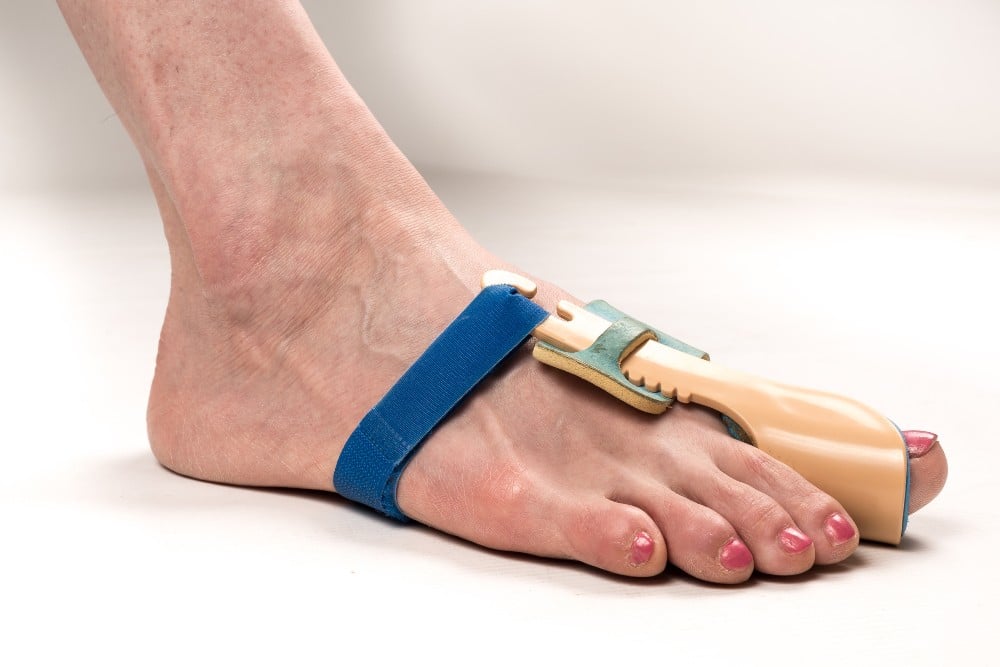Bunions, if we’re being honest, have a reputation for being an “old lady” condition, or maybe something that might happen earlier in life if you wear high heels every day.
There’s admittedly some truth behind that impression. Certainly, the typical American bunion sufferer skews older and more female than the general population.
But it’s far from the whole story. For starters, about 10 percent of people with bunions are men. But perhaps more surprisingly, it’s not that unusual for us to start seeing bunions in kids as young as high school age. In rare cases we see them in kids that are even younger.
But how does something like that even happen? And what can be done about it?

Why Do Some Teenagers Get Bunions?
A lot of people think that bunions are primarily a consequence of wearing tight, unsupportive, or high heeled footwear. But once again, while there’s some truth behind the impression that footwear contributes to bunion formation, this is actually mostly false.
In fact, bunions are believed to be mainly hereditary. Some people, simply because of the way their feet are naturally shaped and structured, are more prone to developing instability in the metatarsophalangeal (MTP) joint—that is, the one at the base of the big toe—as well as the joint at the other end of the metatarsal bone.
This is a big reason why bunions often tend to run in families. If a parent or grandparent had bunions, the chances that you will too are much higher than normal.
If a bunion is already developing during a child’s teenage years (or earlier), you can almost guarantee that genetics are largely to blame—and by far the most common specific culprit is flat feet. If a child never develops a strong arch, they’re more likely to overpronate (turn their feet too far inward) when they walk, and that can put a ton of pressure on the MTP joint.
Besides flat feet, other structural problems or gait abnormalities that can contribute to early bunion formation include high arches, excessive in-toeing or out-toeing, knock knees, tight calf muscles (equinus), or leg length discrepancies. More rarely, there might be a neurological or neuromuscular problem at work.
Tight footwear, while not generally considered an underlying cause, can definitely make the bunion worse and more painful.
Teenage Bunions Should Always Be Treated As Soon As Possible
Of course, we recommend that you see us at the first sign of a bunion regardless of how old you are at the time. That’s just good advice across the board.
But bunions that develop in kids are especially concerning, because it strongly suggests that the underlying structural problem is much more serious in nature. If your teenager is already showing the early signs of a foot deformity, just imagine what it might look like 5, 10, or 20 years down the line. Bunions do not get better over time—only worse.
Maybe you developed a bunion of your own later in life, and so far haven’t done much about it. Maybe it isn’t bothering you all that much, or you’ve decided you’re willing to put up with it. While we definitely disagree with that line of thinking, it is very common.
However, we strongly urge you not to make the same choice on behalf of a teenage child. A bunion that develops in childhood is much more likely to become a severely painful, even debilitating problem in adulthood, and it should be addressed as early as possible to prevent this outcome.
Do not wait for your child to start complaining about pain or difficulty wearing shoes. Call us before it gets to that point. The earlier you seek care for your teen, the more we can help.

How Are Bunions Treated in Teenagers?
In general, the approach to treating bunions in teenagers is similar to our approach with adults. If we can use conservative treatments to alleviate the symptoms of the bunion in the short term, as well as slow the rate at which it progresses, we will prioritize those first.
That said, if a bunion is already starting to develop during childhood, it’s very likely that your child will eventually need surgery to correct it. The catch is that, if your child is still growing and their bones have not reached full maturity, bunion surgery is less likely to be effective over the long term, and the bunion is likely to reappear later.
This is another big reason why it’s so important that we see your teen as soon as possible if they start to develop a bunion. In order to ensure the best possible outcome for your child, it’s critical that we do everything in our power to delay the need for surgery as long as possible.
Common conservative approaches include:
- Making sure your child always wears comfy, supportive shoes that are wide enough at the toe box to accommodate his or her bunion.
- Wearing orthotic inserts that further support their flat feet and protect the bunion from excess pressure.
- Wearing night splints or toe separators.
- Performing toe mobility and strengthening exercises that help keep the joint as resistant to further deterioration as possible.
The discussion of whether to consider surgery, and when, will of course be made on a case-by-case basis depending on the specific needs of your child and all the potential risks and benefits of any procedure. We always want to make sure that parents and children are fully aware of all their options and can make a confident decision.
Please don’t wait for a child to start complaining about painful symptoms before seeking help for a bunion. We have helped many teenagers in this situation maintain their activities and manage their deformity before it has a chance to worsen in adulthood—and we can help your family, too. Call us at (214) 660-0777, or reach out online.


